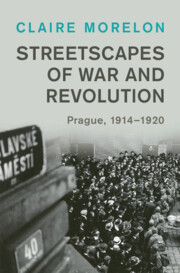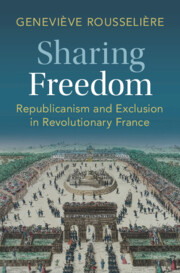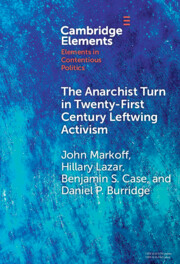363 results
Chapter 2 - Liberalism
- from Part 1 - Theories of International Relations
-
-
- Book:
- An Introduction to International Relations
- Print publication:
- 31 July 2024, pp 34-45
-
- Chapter
- Export citation
Epilogue
-
- Book:
- Migration at the End of Empire
- Published online:
- 30 May 2024
- Print publication:
- 06 June 2024, pp 263-276
-
- Chapter
- Export citation
Chapter 1 - On the Eve
-
-
- Book:
- Nineteenth-Century Literature in Transition: The 1830s
- Published online:
- 30 May 2024
- Print publication:
- 06 June 2024, pp 17-37
-
- Chapter
- Export citation
3 - Twice without a King
-
- Book:
- Migration at the End of Empire
- Published online:
- 30 May 2024
- Print publication:
- 06 June 2024, pp 131-175
-
- Chapter
- Export citation
6 - The End of Darkness? Uncertainty and Revolution
-
- Book:
- Streetscapes of War and Revolution
- Published online:
- 30 May 2024
- Print publication:
- 06 June 2024, pp 253-291
-
- Chapter
- Export citation
“Draw a Guerrilla!” Betrayal, Solitude, and Revolutionary Art
-
- Journal:
- Latin American Research Review ,
- Published online by Cambridge University Press:
- 03 June 2024, pp. 1-15
-
- Article
-
- You have access
- Open access
- HTML
- Export citation

Streetscapes of War and Revolution
- Prague, 1914–1920
-
- Published online:
- 30 May 2024
- Print publication:
- 06 June 2024
1 - Introduction
-
-
- Book:
- Mobility and Coercion in an Age of Wars and Revolutions
- Published online:
- 09 May 2024
- Print publication:
- 16 May 2024, pp 1-27
-
- Chapter
-
- You have access
- Open access
- HTML
- Export citation
“We Are Happy Here”: Creating Communist Cuba and the Mariel Crisis of 1980
-
- Journal:
- Latin American Research Review ,
- Published online by Cambridge University Press:
- 07 May 2024, pp. 1-23
-
- Article
-
- You have access
- Open access
- HTML
- Export citation
Chapter 3 - “O When Will It Suffice?”
-
- Book:
- Yeats, Revival, and the Temporalities of Irish Modernism
- Published online:
- 11 April 2024
- Print publication:
- 18 April 2024, pp 86-120
-
- Chapter
- Export citation

Sharing Freedom
- Republicanism and Exclusion in Revolutionary France
-
- Published online:
- 28 March 2024
- Print publication:
- 04 April 2024
A Sense of a European Present and its Passing during the Revolutions of 1848
-
- Journal:
- Transactions of the Royal Historical Society , First View
- Published online by Cambridge University Press:
- 21 March 2024, pp. 1-21
-
- Article
-
- You have access
- Open access
- HTML
- Export citation
Revolution, War, and Cholera in 1848–49: The Case of Hungary
-
- Journal:
- Austrian History Yearbook , First View
- Published online by Cambridge University Press:
- 20 March 2024, pp. 1-18
-
- Article
- Export citation
Chapter 16 - Revolutionary Politics
- from III - Politics, Ideas, and Bodies
-
-
- Book:
- Wagner in Context
- Published online:
- 14 March 2024
- Print publication:
- 14 March 2024, pp 159-167
-
- Chapter
- Export citation
5 - Radical Suffering
-
-
- Book:
- Percy Shelley for Our Times
- Published online:
- 07 March 2024
- Print publication:
- 14 March 2024, pp 108-132
-
- Chapter
- Export citation
Chapter 9 - Franz Liszt
- from II - People
-
-
- Book:
- Wagner in Context
- Published online:
- 14 March 2024
- Print publication:
- 14 March 2024, pp 95-103
-
- Chapter
- Export citation

The Anarchist Turn in Twenty-First Century Leftwing Activism
-
- Published online:
- 14 March 2024
- Print publication:
- 11 April 2024
-
- Element
- Export citation
2 - Waiting for the Revolution
-
-
- Book:
- Percy Shelley for Our Times
- Published online:
- 07 March 2024
- Print publication:
- 14 March 2024, pp 43-62
-
- Chapter
- Export citation
The Bulgarian connection: the Young Turks in exile and the making of radicalism in Ottoman Europe, 1895–1897
-
- Journal:
- New Perspectives on Turkey / Volume 70 / May 2024
- Published online by Cambridge University Press:
- 12 February 2024, pp. 12-31
- Print publication:
- May 2024
-
- Article
-
- You have access
- Open access
- HTML
- Export citation
4 - Independence(s): What Is a Revolutionary Law?
-
-
- Book:
- The Cambridge History of Latin American Law in Global Perspective
- Published online:
- 15 January 2024
- Print publication:
- 08 February 2024, pp 250-282
-
- Chapter
-
- You have access
- Open access
- HTML
- Export citation



